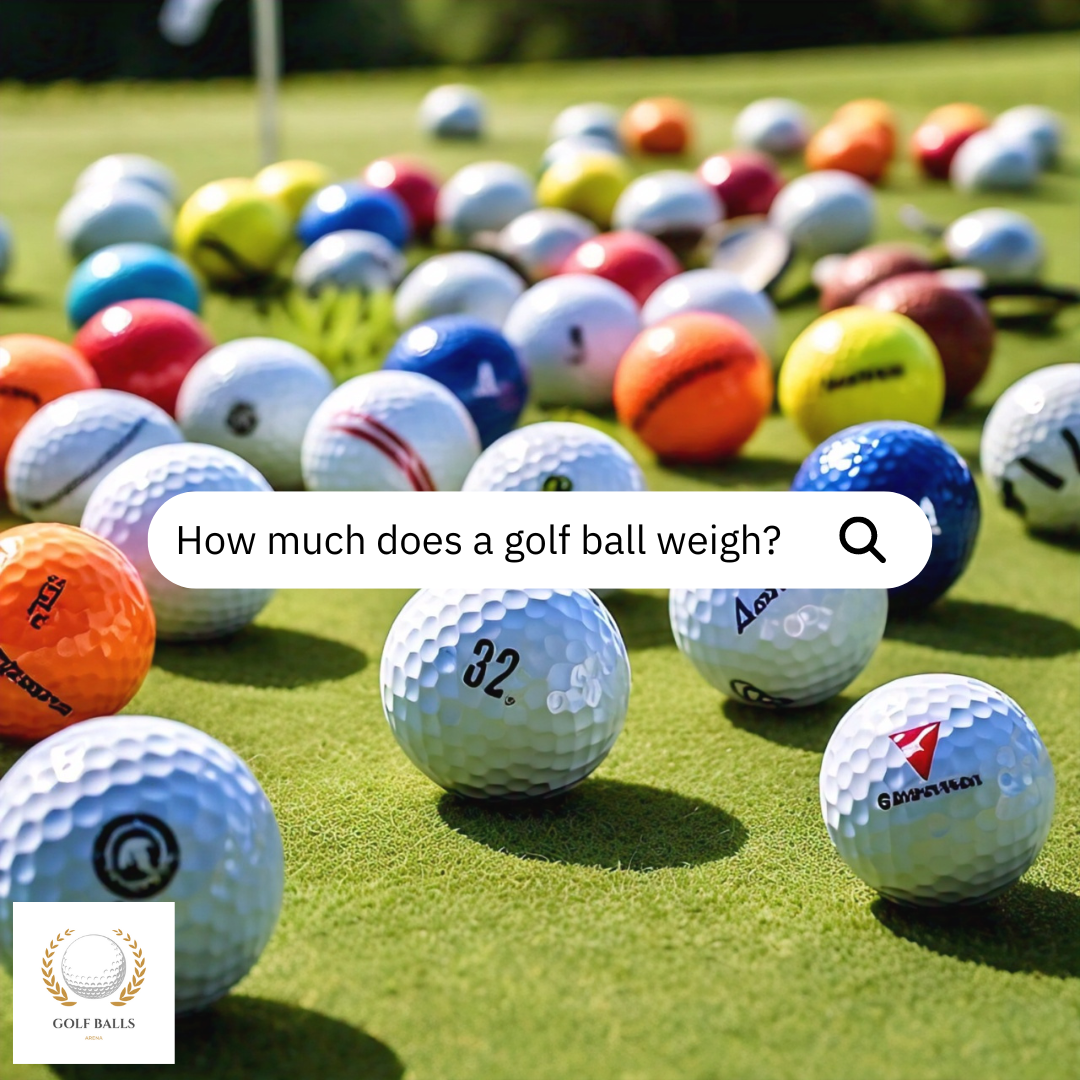How much does a golf ball weigh?
The weight of a golf ball is one of the most crucial factors in determining how it performs during play. The United States Golf Association (U.S.G.A.) and the Royal and Ancient Golf Club of St Andrews (R&A) are the governing bodies regulating the standards for golf balls worldwide. Let’s explore the standard weight of a golf ball, its historical evolution, and how it impacts performance aspects like distance, control, spin, and ball flight. Additionally, we’ll dive into golfer preferences and how clubhead speed, dimple patterns, and ball size play into the equation.
Standard Golf Ball Weight Regulation
Golf regulations commonly consider a golf ball to weigh 1.62 ounces (45.93 grams), the maximum weight allowed. This standard ensures that all golf balls used in competitions match in size and weight. Manufacturers design most modern golf balls to approach this weight limit as closely as possible because heavier balls provide more momentum, which can affect distance, control, and spin.
While the rules specify the maximum weight, the diameter of the ball must also meet a minimum size requirement of 1.680 inches. These dimensions ensure uniformity and fairness across all levels of play, creating a standard foundation for comparing various balls and performance metrics such as distance and control.
Impact on Performance
The weight of a golf ball is essential to its range trajectory, spin, and control, along with the regular feeling throughout play, which is vital to a golf enthusiast’s efficiency and satisfaction with the game.
Distance:
A heavier ball can maintain more momentum, allowing it to travel farther and allowing it to travel farther, particularly for players with higher clubhead speeds. However, there’s a tradeoff; while it might maintain speed better after impact, it may also require more force from the player to launch it at the desired velocity.
Control and spin:
A heavier ball provides more stability in the air, which can help players achieve a more predictable ball flight and control. Knowing the impact of weight is especially important for professional players who rely on precise shots.
Spin:
The weight of the golf ball generally affects the amount of spin generated. Heavier balls typically create more spin, which can be beneficial in specific situations, such as when trying to control the ball on the green.
Dimple Pattern and Ball Flight:
The dimple pattern on a golf ball influences its flight by affecting aerodynamics. The ball’s weight and dimple design critically determine its ability to cut through the air and remain stable. Engineers design different dimple patterns to create specific flight characteristics for the ball, with heavier balls providing more consistent trajectories, particularly in windy conditions.
Historical Context of Golf Ball Weight Regulations
Golf ball weight has not always been standardized. The early golf balls used before the 19th century often needed to be more consistent in weight and performance. Here’s a brief timeline of the evolution of golf ball weight:
Featherie Balls (17th to mid-19th century): The featherie, one of the earliest golf balls, was made by stuffing goose feathers into a leather pouch. These balls weighed between 1.4 and 1.7 ounces, and their inconsistent weight often led to irregular flight and performance.
Guttie Balls (mid-19th century): The advent of the gutta-percha ball, or “guttie,” marked a turning point in the evolution of golf balls. Made from the sap of Malaysian trees, these balls were heavier and more consistent than featheries, typically weighing around 1.6 ounces. Though variations still existed, the guttie set the foundation for future weight standards.
Rubber-Core Balls (1898): The introduction of the Haskell ball, with its rubber core wrapped in gutta-percha, brought a significant shift. These balls closely resembled the modern golf ball in construction and weight, leading to more uniformity. It wasn’t until the 1920s that the U.S.G.A. began formalizing weight standards for competitive play, capping the ball weight at 1.620 ounces.
Modern Standards: In 1930, the weight regulation of 1.620 ounces was solidified by the U.S.G.A. and R&A, providing a standard that has persisted. This regulation ensured fair competition and consistency in how the game was played globally.
Variations Between Brands and Their Effects on Gameplay
Although all golf balls must meet the maximum weight regulation, slight variations in the overall construction can impact their performance. For example, the difference in materials, layer construction, and dimple design can cause subtle changes in how a ball behaves in flight. Players with different skill levels might notice that one ball feels heavier or lighter due to its design, even though the weight remains the same.
These variations allow brands to create golf balls tailored to different types of players. For example, golfers seeking more distance might prefer a ball like the Titleist Pro V1, while those looking for more control on the green might favor the Callaway Chrome Soft.
How Different Players May Perceive And Benefit From Specific Weight Characteristics In Golf Balls?
Various golf players have distinct designs coupled with choices, and the particular weight attributes of golf balls can deal with these variants in play. Right here’s how various gamers may view gain from these attributes:
Beginners: New gamers typically benefit from golf balls that are simpler to strike and also offer more mercy. A ball with an essential weight that provides an excellent balance between range and control can assist novices in attaining far better outcomes as they develop their abilities.
High Handicappers: Players with high handicaps may favor a golf ball that maximizes range and minimizes spin to help decrease the impacts of piece or hook shots. These golf players typically take advantage of balls that lean toward the larger side of the conventional weight array, as they often tend to take a straighter trip.
Low Handicappers: More knowledgeable golf players, or low handicappers, typically search for balls that provide higher control and the capacity to form shots. They may favor golf balls on the lighter side, often giving even more spin and far better maneuverability. This permits them to implement more exact shots, specifically about eco-friendliness.
Professional Golfers: Professionals and very competent beginners use efficient golf balls constantly. They require balls to provide range, feeling, and spin to dip to high degrees.
Conclusion:
In this write-up, we checked out the importance of golf ball weight and how it influences a gamer’s efficiency and pleasure in the game.
Golfers are motivated to explore various golf ball weights to discover the best match their demands. This can be done with test packs, constant screening problems, and efficiency notes to contrast how various weights impact their game.
Whether using a Titleist Pro V1, Callaway Chrome Soft, or TaylorMade TP5, you can be confident that your ball adheres to the highest standards, offering you the best chance to perform at your best.
FAQS
Ball weight is critical because it directly impacts vital aspects of a golf ball’s performance, such as distance, control, and spin. A heavier ball carries more momentum, allowing it to travel further, particularly in windy conditions. It also provides better control due to its stability in flight, making it easier to predict its trajectory. Additionally, the ball’s weight influences how much spin can be generated, which can be vital for precision shots around the green.
There’s no minimum weight for golf balls because lighter balls tend to perform worse in competitive situations. A ball that is too light would be more affected by air resistance and external conditions like wind, resulting in less control and reduced distance. The upper weight limit (1.620 ounces) ensures consistency and fair play, as it optimizes performance without making the ball too heavy to swing comfortably. Regulators ensure the ball performs consistently across different conditions and courses by focusing on the maximum weight.
A golfer might prefer a heavier ball because it offers more stability and control, especially in windy conditions. Heavier balls also tend to generate more spin, which can benefit players who want to shape their shots or control the ball’s behavior on the green. For those with faster swing speeds, a heavier ball can provide more distance due to its ability to maintain momentum after impact.
Professional golfers usually opt for balls that are close to the maximum allowable weight (1.620 ounces). This gives them the best combination of distance, control, and spin. They often test various ball models extensively to find one that complements their swing speed, shot style, and overall performance goals. Manufacturers like Titleist, Callaway, and TaylorMade design golf balls specifically tailored to meet the demanding needs of professional players.
Hi, I'm Austin Grey. I've been passionate about golf since 2005, and over the years, I've immersed myself in every aspect of the game. With nearly two decades of experience, I've developed a deep expertise in one particular area: golf balls. I created this blog to share everything I've learned about golf balls with fellow enthusiasts like you. Here, you'll find detailed reviews, insightful tips, and comprehensive guides to help you choose the perfect ball for your game. Whether you're just starting out or have been playing for years, I'm here to help you enhance your golf experience, one ball at a time.

